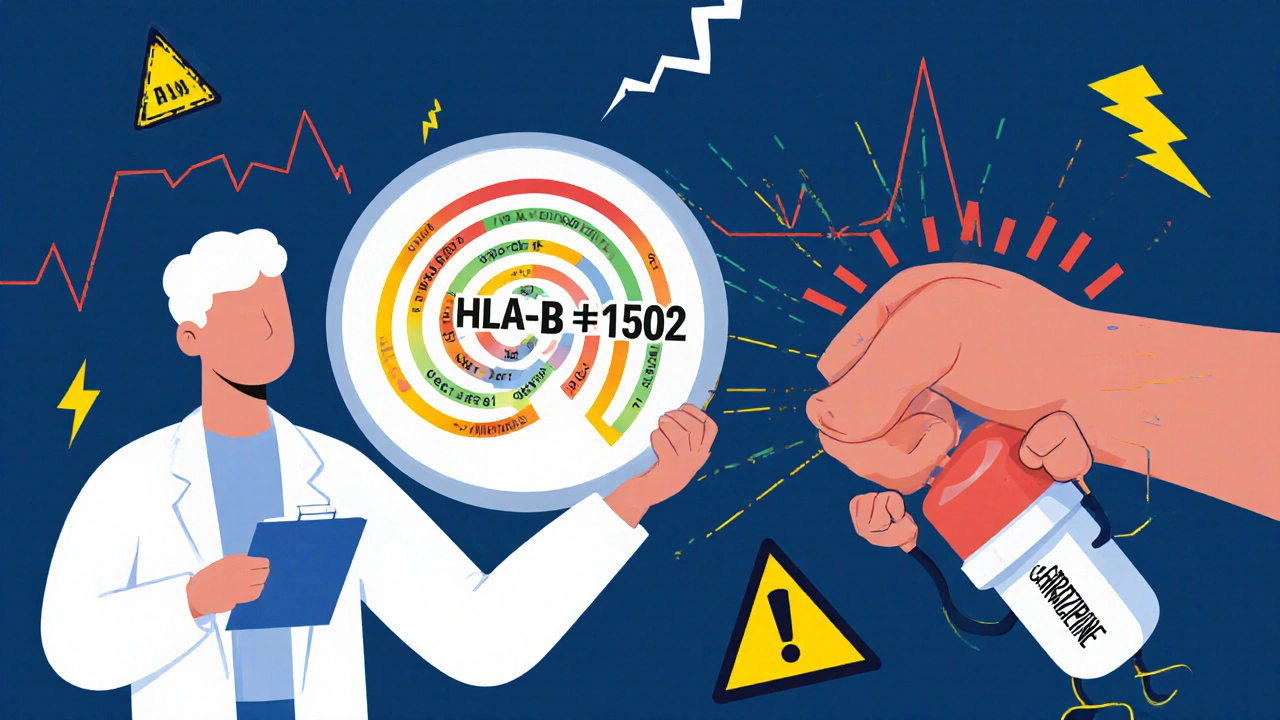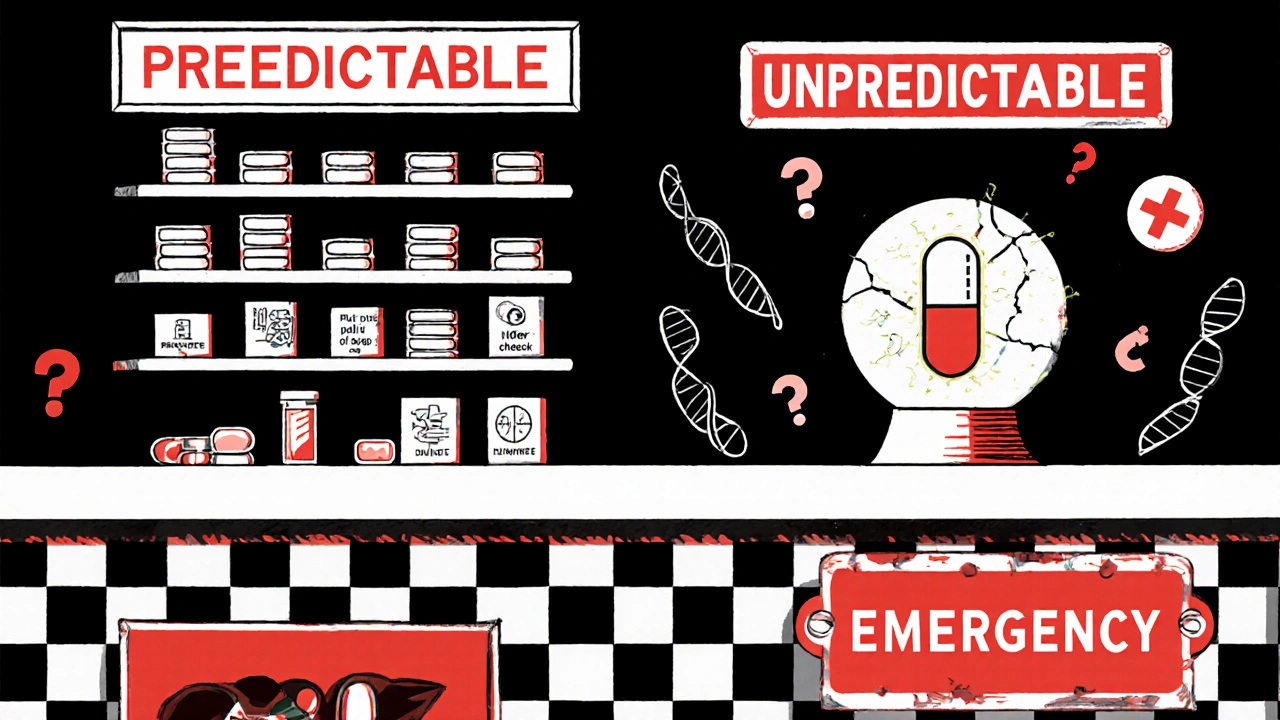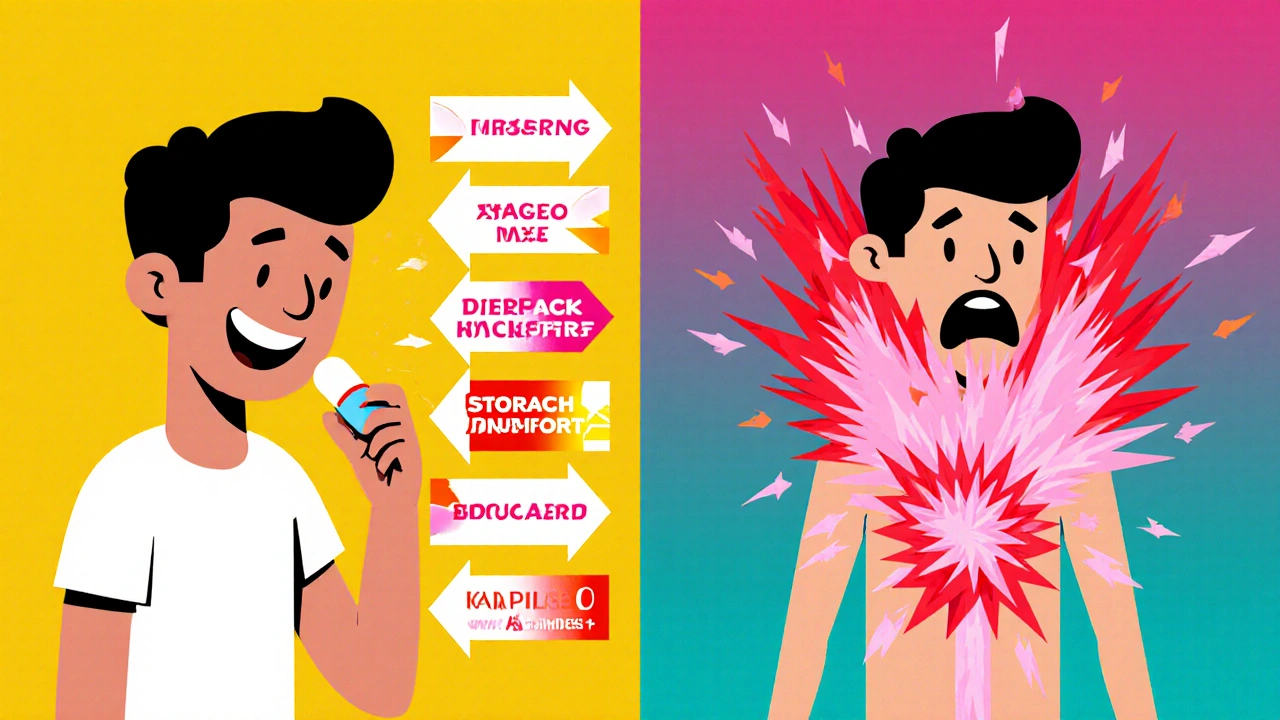Drug Side Effect Type Checker
Discover whether a medication has predictable (Type A) or unpredictable (Type B) side effects based on the science discussed in the article.
Predictable Side Effects (Type A)
Unpredictable Side Effects (Type B)
When you take a pill, you expect it to help - not hurt. But sometimes, medications cause harm. Not because you took too much, not because the drug is broken, but because your body reacts in ways even doctors can’t always predict. That’s where the difference between predictable and unpredictable side effects becomes critical. This isn’t just medical jargon. It’s the line between a minor tweak in your dose and a life-threatening emergency.
What Are Predictable Side Effects?
Predictable side effects - known as Type A reactions - are the most common. They happen because the drug does exactly what it’s supposed to do… just too much. Think of it like turning up the volume on a speaker: the music gets louder, but it’s still music. These reactions are tied directly to the drug’s known mechanism of action.For example, NSAIDs like ibuprofen reduce inflammation by blocking prostaglandins. But prostaglandins also protect your stomach lining. So when you take too much, or even just the normal dose over time, you can get stomach bleeding. That’s not a mistake. It’s a direct, expected consequence. The same goes for blood pressure meds causing dizziness, or opioids making you sleepy. These aren’t rare. They’re so common that 75 to 80% of all adverse drug reactions fall into this category.
The good news? These reactions are usually reversible. If your blood sugar drops too low on metformin, your doctor lowers the dose. If you’re too sedated on a painkiller, you cut back. They’re dose-dependent - meaning the higher the dose, the worse the side effect. That’s why doctors start low and go slow. It’s not just caution. It’s science.
What Are Unpredictable Side Effects?
Unpredictable side effects - Type B reactions - are the scary ones. They don’t make sense. You take the right dose. You’ve never had a problem before. Then, out of nowhere, your skin starts peeling, your lungs swell, or your blood cells start dying. These reactions aren’t caused by the drug’s main effect. They’re caused by your body’s weird, rare response to it.Take carbamazepine, a drug for seizures. In most people, it works fine. But in about 1 in 10,000, it triggers Stevens-Johnson syndrome - a condition where the skin and mucous membranes detach. Why? Because they carry a specific gene variant, HLA-B*1502. That gene doesn’t change how the drug works. It just makes their immune system see it as an invader. And no amount of lowering the dose will stop it. That’s the definition of unpredictable.
Other examples include penicillin allergies, anaphylaxis from vancomycin, or hemolytic anemia in people with G6PD deficiency after taking certain antibiotics. These reactions aren’t about dosage. They’re about biology. And they’re deadly. While they only make up 20-25% of all adverse reactions, they account for 15-20% of serious hospitalizations and most drug withdrawals from the market.
Why the Difference Matters
Knowing whether a side effect is predictable or not changes everything - from how you monitor patients to how you choose drugs.Predictable reactions? You can prevent most of them. Screen for kidney function before giving NSAIDs. Check liver enzymes with statins. Adjust doses based on age or weight. These are standard practices because they work. About 70% of Type A reactions can be avoided just by careful dosing and monitoring.
Unpredictable reactions? That’s harder. You can’t predict them by dose. You can’t avoid them by starting low. The only tools we have are genetic testing and patient history. For example, before prescribing abacavir (an HIV drug), doctors test for HLA-B*5701. If the gene is present, they don’t give the drug. Period. That test has cut abacavir-related hypersensitivity from 8% to less than 1%.
But here’s the problem: we only have genetic tests for a few of these reactions. Right now, we can screen for maybe 30% of the most dangerous Type B reactions. That means 70% still come out of nowhere. An emergency room doctor might see a young, healthy patient break out in blisters after taking acetaminophen - a drug so safe it’s sold over the counter. No prior allergy. No overdose. No warning. Just a genetic lottery they didn’t know they were playing.

Real Cases, Real Consequences
In 2020, a 24-year-old woman took sulfamethoxazole for a urinary tract infection. She’d taken antibiotics before. No issues. Within three days, she developed toxic epidermal necrolysis - over 30% of her skin detached. She died. That’s a Type B reaction. No one saw it coming. No dose adjustment could have saved her.Compare that to a 68-year-old man on metformin who developed severe hypoglycemia after starting the drug. His blood sugar dropped to 48 mg/dL. He was confused, shaky, barely awake. But his doctor knew what happened. Metformin increases insulin sensitivity. In older adults with reduced kidney function, it can build up. The fix? Lower the dose. He was discharged in two days. That’s Type A. Predictable. Preventable.
These aren’t rare stories. A 2023 survey of 427 physicians found that 78% saw NSAID-related stomach bleeding as their most common predictable reaction. Meanwhile, 63% said penicillin allergy was their most frequent unpredictable concern. One ER physician on Reddit described a patient who developed Stevens-Johnson syndrome after a single dose of acetaminophen - and tested negative for every known genetic marker. "Truly unpredictable," he wrote.
The Hidden Cost of Side Effects
It’s not just about health. It’s about money. The U.S. spends about $30.1 billion a year treating adverse drug reactions. Of that, $22.6 billion goes to predictable reactions. Why? Because they’re so common. Millions of people get stomach bleeding, dizziness, or nausea every year. It adds up.But the $7.5 billion spent on unpredictable reactions? That’s for the rare, catastrophic ones - ICU stays, skin grafts, organ failure, death. One Type B reaction can cost more than a hundred Type A ones. That’s why drug companies and regulators are pouring money into pharmacovigilance. The global market for monitoring drug safety is expected to hit $1.2 billion by 2027.
The FDA has over 60 active Risk Evaluation and Mitigation Strategies (REMS) programs - mostly for drugs with high Type B risk. These require special training, restricted distribution, or mandatory testing before prescribing. It’s expensive. It’s complicated. But it’s necessary.

What’s Changing Now?
The future of drug safety is personal. Not just in how we treat disease - but in how we avoid harm.Pharmacogenomics is growing. In 2015, only 5% of U.S. hospitals used genetic testing to guide drug choices. By 2023, that number jumped to 38%. Tests for HLA-B*5701 (abacavir), CYP2C9/VKORC1 (warfarin), and TPMT (azathioprine) are now standard in many clinics. The NIH’s All of Us program has found 17 new gene-drug links, including one linking HLA-B*15:02 to phenytoin reactions in non-Asian populations - something we didn’t know until recently.
Artificial intelligence is stepping in too. Google Health trained a model on 10 million electronic health records. It could predict Type A reactions with 89% accuracy. But for Type B? Only 47%. Why? Because unpredictable reactions depend on complex gene-environment interactions - not just one gene, but hundreds, plus diet, infections, other meds, even gut bacteria. We’re still far from cracking that code.
The goal? The International Serious Adverse Events Consortium wants to cut severe Type B reactions by 50% by 2030. That means widespread genetic screening, better data sharing, and smarter tools. But it also means accepting that some risks will always be hidden. No matter how advanced our tech gets, biology will always have surprises.
What You Can Do
If you’re on medication, here’s what matters:- Know your drugs. Ask your pharmacist: "What are the common side effects? Are there any rare but serious ones?"
- Report anything unusual - even if it seems small. A rash, fever, or sudden fatigue could be the first sign of a Type B reaction.
- If you’ve had a bad reaction before, tell every doctor. Even if it was years ago. Even if you thought it was "just a fluke."
- Ask if genetic testing is available for your medication. Especially if you’re taking anticonvulsants, HIV drugs, or certain antidepressants.
- Don’t assume a drug is safe because it’s "over the counter." Acetaminophen, aspirin, and NSAIDs cause serious reactions - predictable and unpredictable - every day.
Doctors aren’t mind readers. They rely on you to notice the warning signs. And sometimes, that one call - "I feel different" - is the thing that saves your life.
What’s the difference between a side effect and an allergic reaction?
A side effect is any unintended effect of a drug, whether predictable or not. An allergic reaction is a specific type of unpredictable reaction where the immune system overreacts to the drug, often causing hives, swelling, or anaphylaxis. Not all unpredictable reactions are allergies - some are idiosyncratic or pseudoallergic - but all allergic reactions are unpredictable.
Can you outgrow a drug allergy?
Sometimes, yes. Penicillin allergies, for example, can fade over time. About 80% of people who think they’re allergic to penicillin aren’t - they had a reaction once, maybe as a child, and never got tested. A simple skin test can confirm if you’re still allergic. Never assume you’re still allergic without checking.
Are generic drugs more likely to cause unpredictable side effects?
No. Generic drugs contain the same active ingredient as brand-name versions and are required to meet the same safety and effectiveness standards. Unpredictable reactions are tied to your genetics or immune system, not whether the drug is generic or brand. If you had a reaction to a brand-name drug, you’re likely to react the same way to the generic.
Why do some people have reactions to drugs others take safely?
It’s mostly genetics. Your genes control how your body breaks down drugs, how your immune system responds, and how sensitive your organs are. Two people can take the same dose of the same drug - one feels fine, the other ends up in the hospital. That’s not bad luck. It’s biology. That’s why personalized medicine is becoming so important.
Can you prevent unpredictable side effects?
You can reduce the risk, but not eliminate it. Genetic testing helps for some drugs - like abacavir or carbamazepine. But for most, there’s no test. The best prevention is knowing your history, reporting early symptoms, and avoiding drugs you’ve reacted to before. Always tell your doctor about any past reactions, even if they seemed minor.

